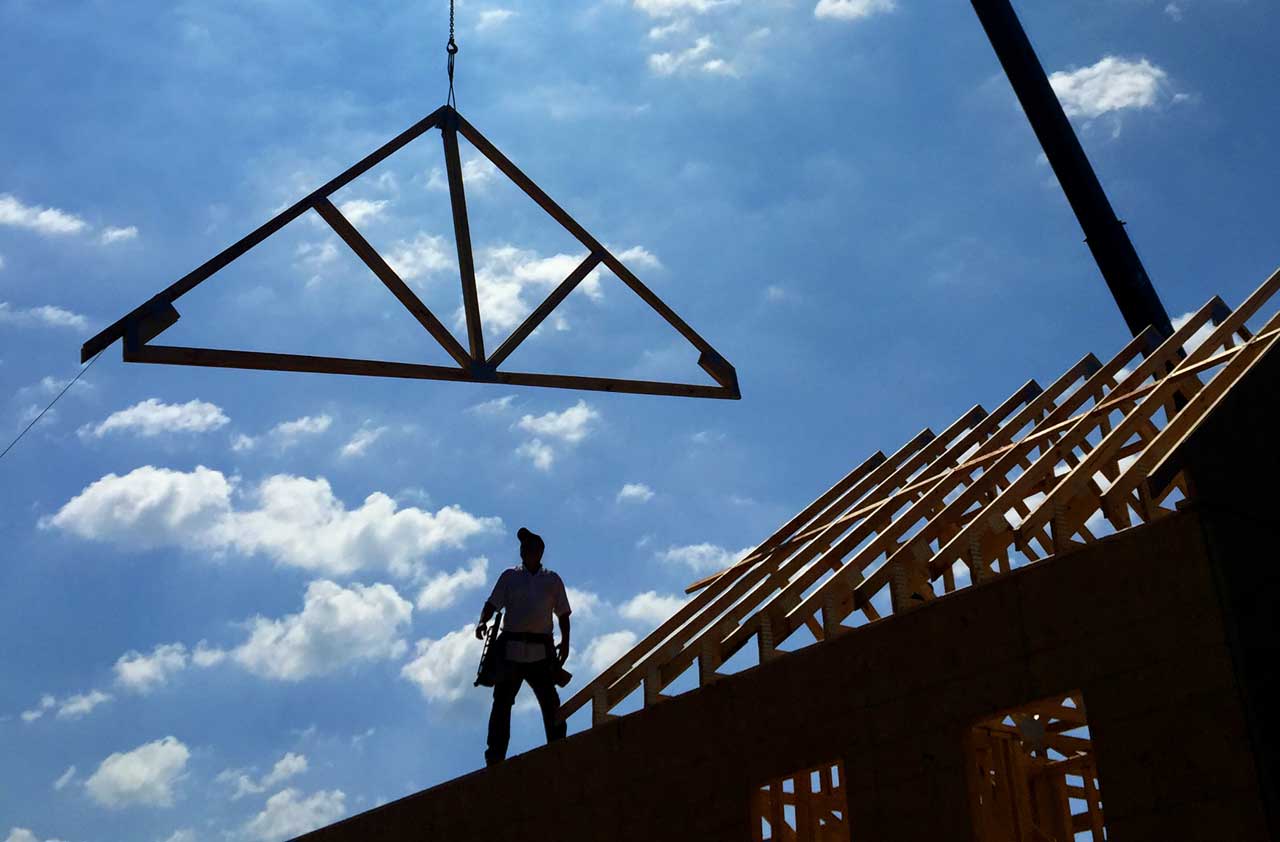More Gains in Store for Homebuilders
Recommending homebuilders’ stocks isn’t the contrarian call it used to be. Now the concern is that they might be overvalued. But I think they still have room to run.


The housing market reached a milestone in January that almost no one noticed. The S&P CoreLogic Case-Shiller Composite, an index that tracks average home prices in 20 U.S. cities, finally rose above the record set in April 2006. Is it cause for celebration or trepidation?
A bit of both. The good news is that more Americans are getting a home of their own, and those who already have one are seeing the value of a valuable asset rise. The bad news is that, by historical standards, homes may be getting too expensive. “Of the nation's 50 largest housing markets, 52% were considered overvalued in April,” reported CNBC, drawing on a housing consulting firm’s analysis.
After the housing bubble popped in 2006, prices continued to drift lower for years, not reaching bottom until 2012. Since then, they have risen more than 50%. And the boom shows no signs of abating. It costs, on average, 6.9% more to buy a house than it did a year ago.
From just $107.88 $24.99 for Kiplinger Personal Finance
Become a smarter, better informed investor. Subscribe from just $107.88 $24.99, plus get up to 4 Special Issues

Sign up for Kiplinger’s Free Newsletters
Profit and prosper with the best of expert advice on investing, taxes, retirement, personal finance and more - straight to your e-mail.
Profit and prosper with the best of expert advice - straight to your e-mail.
Companies that buy land and build homes on it have been huge beneficiaries. PulteGroup (symbol PHM, $30) more than doubled its revenues from 2011 to 2017, and the Value Line Investment Survey expects growth of 12% this year. Homebuilder stocks have extreme ups and downs. Although I like to buy shares of good companies and hold on through thick and thin, perseverance is nearly impossible with most homebuilders. This sector is among the few in your portfolio that can be bought and sold and bought and sold again. (Stocks I like are in bold; prices are as of June 15.)
A good call. There are times when the world gives up on homebuilders, as though no one will ever construct or sell a new house again. One of those times was in August 2011, when I began my column this way: “Suggest that now might be a good time to buy the stocks of homebuilders, and you will almost certainly be considered out of your mind.” In the wake of the recession, prices had plunged and prospects were dim.
You can never get the bottoms and tops exactly right with homebuilders, but you can profit by closely observing history.
It was the ultimate contrarian moment. I recommended the stocks of two homebuilders and one exchange-traded fund. One of the companies, Pulte, had peaked in mid 2005 at about $48 a share and dropped to $8 by mid 2011, when I suggested it. Today, it’s $30. Ryland Group more than doubled after my recommendation, then it merged with Standard Pacific four years later to become CalAtlantic Homes, which was acquired at a further premium in 2017 by Lennar. The iShares U.S. Home Construction ETF more than tripled in seven years.
Enough back-patting. My point is that homebuilder stocks are cyclical and volatile. Consider Beazer Homes USA (BZH, $15), an Atlanta-based builder, whose stock fell from $410 a share in January 2006 to $1.25 in March 2009. Even after seven straight years of losses, from 2007 through 2013, Beazer survived and now trades at $15
You can never get the bottoms and tops exactly right with homebuilders, but you can profit by closely observing history. Take Pulte, for example. Operating in 47 markets, Pulte builds and sells homes with an average price of $395,000, compared with a national median of $312,000. While the Great Recession officially began in December 2007, Pulte’s stock price, like Beazer’s, peaked about two years earlier; similarly, although the Case-Shiller index didn’t hit its cyclical low until 2012, Pulte stock bottomed close to a year earlier. Markets anticipate.So where are we in the cycle today? In 2017, shares of Pulte soared 82.9%; Beazer jumped 44.4%; D.R. Horton (DHI, $43), the largest homebuilder by revenue, rose 88.4%; and the iShares home-construction ETF that I recommended in 2011 increased 59.7%—all compared with a price increase of 21.8% for the benchmark Standard & Poor’s 500-stock index. So far in 2018, however, Pulte has fallen 8.1%, Beazer has dropped 21.5%, Horton is down 15.6%, and the ETF is off 9.7%, compared with a gain of 4.9% for the S&P.
Another bubble? What’s bothering investors may be the worry that history is repeating itself. For example, federal housing finance agencies are lowering their lending standards, just as they did during the mid 2000s. Two of my former colleagues at the American Enterprise Institute, Paul H. Kupiec and Edward J. Pinto, wrote in the Wall Street Journal in June that “the current pace of home-price inflation is increasing the risk of another housing bubble” and that the bubble is being fed by lower requirements for down payments—just 3% of home prices—by Freddie Mac, Fannie Mae and the Federal Housing Administration. Fannie also raised its debt-to-income limit to 50% last year, allowing people to take bigger loans, and new government regulations have, in effect, boosted credit scores for mortgage borrowers. The lower underwriting standards help fuel inflated home prices.
Also in common with the last time around, interest rates are rising. The 30-year fixed-rate mortgage in May, the most recent month reported by Freddie Mac, carried an average rate of 4.6%, compared with 3.6% two years earlier. As the economy grows briskly and the Federal Reserve continues to raise short-term rates, longer-term mortgage rates are likely to follow suit. A $500,000 mortgage requires monthly principal-and-interest payments of $2,387 at a rate of 4% and $2,998 at 6%.
Still, current rates remain low by historical standards. Perhaps more important, the proportion of Americans who own their own homes has only recently started to rise from the recent low of mid 2016. At this stage in the business cycle, with inflation and interest rates still moderate, a briskly growing economy is more positive than negative for homebuilders

Several stocks are attractive. Pulte “remains one of the industry’s most conservative homebuilders,” writes William Ferguson of Value Line, with a “risk-averse strategy, not overextending its construction pace.” Pulte also has one of the better balance sheets in the sector. Value Line expects earnings to rise an average of 15.5% annually for the next five years. The shares carry a price-earnings ratio of just 9, based on analysts’ forecasts for 2018 earnings.
Another favorite of mine is NVR (NVR, $3,182), which focuses on the Washington, D.C., and Baltimore areas; it also owns Ryan Homes. The downturn of a decade ago harmed NVR stock less than the stock of other homebuilders, and NVR shares have tripled in the past four and a half years. (Note that NVR shares carry one of the highest absolute prices in the market: more than $3,000 each.) The stock’s P/E, based on estimates for 2018, is 16. D.R. Horton, whose homes cost from $100,000 to $1 million, has experienced powerful growth in the past five years, with revenues rising an average of more than 20% annually and earnings up more than 30% a year. The stock’s P/E, based on 2018 profit estimates, is 11. And if you are willing to take more risk, consider Beazer.
Finally, I like SPDR S&P Homebuilders (XHB), an ETF that, unlike the iShares Home Construction ETF, does not include tangentially related retailers, such as Williams Sonoma and Lowe’s.
Homebuilders have weathered tough times before, and although I am wary, I don’t believe the sector has entered a downward cycle yet. The best strategy is to watch the stocks and the ETF carefully and buy them regularly, laying out the same amount for purchases monthly or quarterly. Don’t put too much in the sector, and don’t fret about bailing out if it gets too scary. That’s the nature of home building.
James K. Glassman chairs Glassman Advisory, a public-affairs consulting firm. He does not write about his clients.
Profit and prosper with the best of Kiplinger's advice on investing, taxes, retirement, personal finance and much more. Delivered daily. Enter your email in the box and click Sign Me Up.

-
 Don't Wait Until January: Your Year-End Health Checklist to Kickstart 2026
Don't Wait Until January: Your Year-End Health Checklist to Kickstart 2026Skip the fleeting resolutions and start the new year with a proactive plan to optimize your longevity, cognitive health, and social vitality.
-
 Premium Rewards Cards: More Perks, Higher Fees
Premium Rewards Cards: More Perks, Higher FeesSome issuers are hiking the annual fee on their flagship luxury credit cards by hundreds of dollars. Are they still worth using?
-
 3 Trips to Escape the Winter Doldrums, Including An Epic Cruise
3 Trips to Escape the Winter Doldrums, Including An Epic CruiseThree winter vacation ideas to suit different types of travelers.
-
 How Inflation, Deflation and Other 'Flations' Impact Your Stock Portfolio
How Inflation, Deflation and Other 'Flations' Impact Your Stock PortfolioThere are five different types of "flations" that not only impact the economy, but also your investment returns. Here's how to adjust your portfolio for each one.
-
 Why I Still Won't Buy Gold: Glassman
Why I Still Won't Buy Gold: GlassmanOne reason I won't buy gold is because while stocks rise briskly over time – not every month or year, but certainly every decade – gold does not.
-
 Should You Use a 25x4 Portfolio Allocation?
Should You Use a 25x4 Portfolio Allocation?The 25x4 portfolio is supposed to be the new 60/40. Should you bite?
-
 Retirement Income Funds to Keep Cash Flowing In Your Golden Years
Retirement Income Funds to Keep Cash Flowing In Your Golden YearsRetirement income funds are designed to generate a reliable cash payout for retirees. Here are a few we like.
-
 10 2024 Stock Picks From An Investing Expert
10 2024 Stock Picks From An Investing ExpertThese 2024 stock picks have the potential to beat the market over the next 12 months.
-
 Special Dividends Are On The Rise — Here's What to Know About Them
Special Dividends Are On The Rise — Here's What to Know About ThemMore companies are paying out special dividends this year. Here's what that means.
-
 How to Invest in AI
How to Invest in AIInvestors wanting to know how to invest in AI should consider these companies that stand to benefit from the boom.
-
 Why I Still Like Emerging Markets
Why I Still Like Emerging MarketsPeriods of global instability create intriguing possibilities in emerging markets. Here are a few.